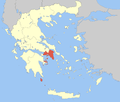Eleusis
Eleusis (Greek: Ελευσίνα Elefsina, Ancient Greek: Ἐλευσίς Eleusis) is a town and municipality in West Attica Regional unit in Greece. It is situated about 18 kilometres (11 miles) northwest from the centre of Athens and is part of its Metropolitan area. It is located in the Thriasian Plain, at the northernmost end of the Saronic Gulf. North of Eleusis are Mandra and Magoula, while Aspropyrgos is to the northeast.
Eleusis Ελευσίνα | |
|---|---|
%2C_center_for_the_Eleusinian_Mysteries%2C_Eleusis_(8191841684).jpg) View over the excavation site towards Eleusis. | |
 Eleusis Location within the region  | |
| Coordinates: 38°2′N 23°32′E | |
| Country | Greece |
| Administrative region | Attica |
| Regional unit | West Attica |
| Government | |
| • Mayor | Argyris Oikonomou |
| Area | |
| • Municipality | 36.589 km2 (14.127 sq mi) |
| • Municipal unit | 18.455 km2 (7.126 sq mi) |
| Highest elevation | 5 m (16 ft) |
| Lowest elevation | 0 m (0 ft) |
| Population (2011)[1] | |
| • Municipality | 29,902 |
| • Municipality density | 820/km2 (2,100/sq mi) |
| • Municipal unit | 24,901 |
| • Municipal unit density | 1,300/km2 (3,500/sq mi) |
| Time zone | UTC+2 (EET) |
| • Summer (DST) | UTC+3 (EEST) |
| Postal code | 192 00 |
| Area code(s) | 210 |
| Website | www |
It is the site of the Eleusinian Mysteries and the birthplace of Aeschylus. Today, Eleusis is a major industrial centre, with the largest oil refinery in Greece as well as the home of the Aeschylia Festival, the longest-lived arts event in the Attica Region.
On 11 November, 2016, Eleusis was named the European Capital of Culture for 2021.
Etymology
The word Eleusis first appears at the Orphic hymn «Δήμητρος Ελευσινίας, θυμίαμα στύρακα[2]». Also Hesychius of Alexandria reports that the older name for Eleusis was Saesara (Σαισάρια). Saesara was the mythic daughter of Celeus (king of Eleusis when Demeter arrived for the first time) and granddaughter of Eleusinus, the first settler of Eleusis.[3]
Municipality
The municipality Elefsina was formed at the 2011 local government reform by the merger of the following two former municipalities, that became municipal units:[4]
- Elefsina
- Magoula
The municipality has an area of 36.589 km2 (14.127 sq mi), and the municipal unit has an area of 18.455 km2 (7.126 sq mi).[5]
History
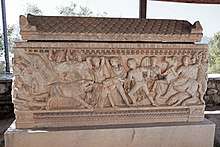
Ancient
Eleusis was a deme of ancient Attica, belonging to the phyle Hippothoöntis. It owed its celebrity to its being the chief seat of the worship of Demeter and Persephone, and to the mysteries celebrated in honour of these goddesses, which were called the Eleusinia, and continued to be regarded as the most sacred of all the Grecian mysteries down to the fall of paganism.
Eleusis stood upon a height at a short distance from the sea, and opposite the island of Salamis.[6] Its situation possessed three natural advantages. It was on the road from Athens to the Isthmus of Corinth; it was in a very fertile plain; and it was at the head of an extensive bay, formed on three sides by the coast of Attica, and shut in on the south by the island of Salamis. The town itself dates from the most ancient times.
Mythology and Proto-history
It appears to have derived its name from the supposed advent (ἔλευσις) of Demeter, though some traced its name from an eponymous hero Eleusis.[7] It was one of the 12 independent states into which Attica was said to have been originally divided.[8] It was related that in the reign of Eumolpus, king of Eleusis, and Erechtheus, king of Athens, there was a war between the two states, in which the Eleusinians were defeated, whereupon they agreed to acknowledge the supremacy of Athens in every thing except the celebration of the mysteries, of which they were to continue to have the management.[9][10] Eleusis afterwards became an Attic deme, but in consequence of its sacred character it was allowed to retain the title of polis (πόλις)[11][7] and to coin its own money, a privilege possessed by no other town in Attica, except Athens. The history of Eleusis is part of the history of Athens. Once a year the great Eleusinian procession travelled from Athens to Eleusis, along the Sacred Way.
Eleusinian Mysteries
.jpg)
Eleusis was the site of the Eleusinian Mysteries, or the Mysteries of Demeter and Kore, which became popular in the Greek speaking world as early as 600 BC, attracted initiates during Roman Empire before declining mid-late 4th century AD.[12] These Mysteries revolved around a belief that there was a hope for life after death for those who were initiated. Such a belief was cultivated from the introduction ceremony in which the hopeful initiates were shown a number of things including the seed of life in a stalk of grain. The central myth of the Mysteries was Demeter's quest for her lost daughter (Kore the Maiden, or Persephone) who had been abducted by Hades. It was here that Demeter, disguised as an old lady who was abducted by pirates in Crete, came to an old well where the four daughters of the local king Keleos and his queen Metaneira (Kallidike, Kleisidike, Demo and Kallithoe) found her and took her to their palace to nurse the son of Keleos and Metaneira, Demophoon. Demeter raised Demophoon, anointing him with nectar and ambrosia, until Metaneira found out and insulted her. Demeter arose insulted, and casting off her disguise, and, in all her glory, instructed Meteneira to build a temple to her. Keleos, informed the next morning by Metaneira, ordered the citizens to build a rich shrine to Demeter, where she sat in her temple until the lot of the world prayed to Zeus to make the world provide food again.
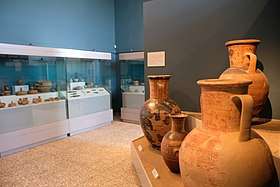
Secular history
During the Greco-Persian Wars, the ancient temple of Demeter at Eleusis was burnt by the Persians in 484 BC;[13] and it was not till the administration of Pericles that an attempt was made to rebuild it. When the power of the Thirty Tyrants was overthrown after the Peloponnesian War, they retired to Eleusis, which they had secured beforehand, but where they maintained themselves for only a short time.[14] Under the Romans Eleusis enjoyed great prosperity, as initiation into its mysteries became fashionable among the Roman nobles. It was destroyed by Alaric I in 396 CE, and from that time disappears from history.
Pausanias has left us only a very brief description of Eleusis;[15]
The Eleusinians have a temple of Triptolemus, another of Artemis Propylaea, and a third of Poseidon the Father, and a well called Callichorum, where the Eleusinian women first instituted a dance and sang in honour of the goddess. They say that the Rharian plain was the first place in which corn was sown and first produced a harvest, and that hence barley from this plain is employed for making sacrificial cakes. There the so-called threshing-floor and altar of Triptolemus are shown. The things within the wall of the Hierum [i.e., the temple of Demeter] a dream forbade me to describe.
The Rharian plain is also mentioned in the Homeric Hymn to Artemis;[16] it appears to have been in the neighbourhood of the city; but its site cannot be determined.
The temple of Demeter itself, sometimes called ὁ μυστικὸς σηκός, or τὸ τελεστήριον, was the largest in all Greece, and is described by Strabo as capable of containing as many persons as a theatre.[17] The plan of the building was designed by Ictinus, the architect of the Parthenon at Athens; but it was many years before it was completed, and the names of several architects are preserved who were employed in building it. Its portico of 12 columns was not built till the time of Demetrius Phalereus, about 318 BC, by the architect Philo.[17][18] When finished, it was considered one of the four finest examples of Grecian architecture in marble. It faced the southeast.
The town of Eleusis and its immediate neighbourhood were exposed to inundations from the river Cephissus, which, though almost dry during the greater part of the year, is sometimes swollen to such an extent as to spread itself over a large part of the plain. Demosthenes alludes to inundations at Eleusis;[19] and Hadrian raised some embankments in the plain in consequence of an inundation which occurred while he was spending the winter at Athens.[20] To the same emperor most likely Eleusis was indebted for a supply of good water by means of the aqueduct, the ruins of which are still seen stretching across the plain from Eleusis in a north-easterly direction.
Medieval and early Modern era

It is indicative that writers of the Byzantine era refer to it as a "small village", and shortly before the Ottoman domination the area was deserted by wars, raids and captives. During this period was settled by Arvanites. European travelers during the Ottoman domination described Eleusis as having few inhabitants and many ancient ruins.
Modern Elefsina
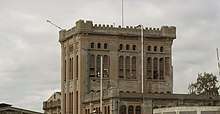
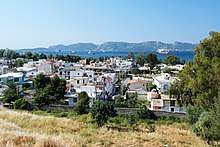
In 1829, after the Greek War of Independence, Eleusis was a small settlement of about 250 inhabitants. By the late 19th century Eleusis changed drastically as new buildings were erected by the new merchant settlers. Also during that period Eleusis became one of the main industrial centers of the Modern Greek State with concrete factory TITAN, Charilaou Soap Factory as well as the distilleries of Botrys and Kronos being established in the area.[21]
Many Greek families of Asia Minor settled in Elefsina after the 1922 Asia Minor Catastrophe and created the settlement of Upper Elefsina, doubling its total population and enriching the region culturally and economically.[22]
During the Axis occupation of Greece (1941–1945), strong resistance developed within the city, the factories and the military airport, which once stationed Squadron 80, the squadron that Roald Dahl[23] was assigned to in the RAF. After World War II, workers from all parts of Greece moved to Elefsina to work in the industries in the region. Industrial activity, however, developed anarchically on the antiquities and next to the residential area.
Environmental pollution has taken on large dimensions. During the 20th century, at the time of sustainable development, archaeological discoveries and industrial formation shaped the image of contemporary Eleusis.
In 1962, a large house of priests from the Roman era was discovered. Pollution thanks to citizens' struggles gradually has fallen.
Today, the city has become a suburb of Athens, to which it is linked by the Motorway 6 and Greek National Road 8. Eleusina is nowadays a major industrial area, and the place where the majority of crude oil in Greece is imported and refined. The largest refinery is located on the west side of town, right beside where the annual Aeschylia Festival is held in honor of the great tragic poet Aeschylus.
There is a military airport a few kilometers east of Eleusis. Eleusis Airfield played a crucial role in the final British evacuation during the 1941 Battle of Greece, as recounted by Roald Dahl in his autobiography Going Solo.
Eleusis is home to the football club Panelefsiniakos F.C., and the basketball club Panelefsiniakos B.C.
Aeschylia Festival
Established in 1975, the Aeschylia Festival in Eleusis in Western Attica is the currently the longest standing cultural event organized by an Attica Municipality. It is annually held at "Palaio Elaiourgeio" a former soap factory by the seafront now transformed to function as an open theatre. The Festival is usually running at the end of August and during all of the September. The event is organized in honor of the tragic poet Aeschylus, who was born in Eleusis, from whom it also derives its name. It includes stage productions, art exhibitions and installations, concerts, and dance events.
Climate
The Hellenic National Meteorological Service (HNMS) weather station of Eleusis has an average maximum July temperature of 33.0 °C (91.4 °F) (1958–2001 HNMS)[24] The Eleusis phenomenon is not yet completely understood; however, factors of geomorphology, warm water masses in the summer and warm winds might be responsible for its summer climate.[24] According to Kassomenos and Katsoulis (2006), based on 12 years of data (1990–2001), the industrialization of west Attica, where at least 40% of the industrial activity of the country is concentrated, could be the cause of the warm climate of the zone.[25] According to the Köppen Climate Classification system, Eleusis has a hot-summer Mediterranean climate, abbreviated "Csa" on climate maps.[26]
| Climate data for Elefsina, Greece (1958–1997) | |||||||||||||
|---|---|---|---|---|---|---|---|---|---|---|---|---|---|
| Month | Jan | Feb | Mar | Apr | May | Jun | Jul | Aug | Sep | Oct | Nov | Dec | Year |
| Average high °C (°F) | 13.0 (55.4) |
13.6 (56.5) |
15.8 (60.4) |
20.1 (68.2) |
25.7 (78.3) |
30.6 (87.1) |
32.9 (91.2) |
32.7 (90.9) |
28.9 (84.0) |
23.2 (73.8) |
18.5 (65.3) |
14.7 (58.5) |
22.5 (72.5) |
| Average low °C (°F) | 5.4 (41.7) |
5.6 (42.1) |
7.1 (44.8) |
10.1 (50.2) |
14.9 (58.8) |
19.5 (67.1) |
22.3 (72.1) |
22.2 (72.0) |
18.8 (65.8) |
14.6 (58.3) |
10.4 (50.7) |
7.2 (45.0) |
13.2 (55.7) |
| Average precipitation mm (inches) | 48.4 (1.91) |
40.1 (1.58) |
39.3 (1.55) |
26.7 (1.05) |
19.5 (0.77) |
8.4 (0.33) |
5.5 (0.22) |
5.4 (0.21) |
11.3 (0.44) |
41.6 (1.64) |
58.8 (2.31) |
67.9 (2.67) |
372.9 (14.68) |
| Source: Hellenic National Meteorological Service[27] | |||||||||||||
Hospitals and medical centres
Eleusis has only one general hospital the Thriassio General Hospital, located 3.9 km north of the city centre.
Historical population
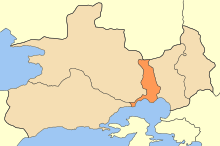
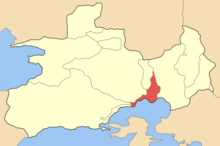
| Year | Municipal unit | Municipality |
|---|---|---|
| 1981 | 20,320 | - |
| 1991 | 22,793 | - |
| 2001 | 25,863 | - |
| 2011 | 24,901 | 29,902 |
Sports
Eleusina hosts the multi-sport club Panelefsiniakos with successful sections in football and basketball. Another historical club of Eleusina is Iraklis Eleusis, founded in 1928.
| Notable sport clubs based in Eleusis | |||
|---|---|---|---|
| Club | Sports | Founded | Achievements |
| Iraklis Eleusis | Football | 1928 | Earlier presence in Gamma Ethniki |
| Panelefsiniakos | Football | 1931 | Earlier presence in A Ethniki |
| Basketball | 1969 | Earlier presence in A1 Ethniki | |
| O.K.E. | Basketball | 1996 | |
Notable people
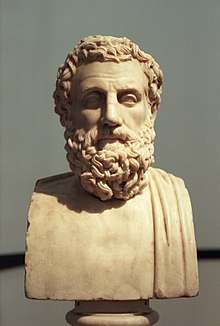
- Aeschylus (c. 525 BC/524 BC – c. 456 BC/455 BC), playwright and veteran of the Battle of Marathon
- Theodoros Pangalos (1878–1952), general
- Stelios Kazantzidis (1931–2001), singer
- Vasilis Laskos (1899–1943), commander of submarine Katsonis, a hero of the Second World War
- Orestis Laskos (1908–1992), director, screenwriter and actor
- Vangelis Liapis (1914–2008), scholar and folklorist
- Theodoros Pangalos (1938– ), politician
- Alexandros Kontoulis, military officer
- Ioannis Kalitzakis (1966- ), footballer
- Katerina Mouriki (1951-), children's novelist
- Panagiotis Lafazanis (1951-), politician
Gallery
.jpg)
 Ruins of the Telesterion at the Sanctuary of Demeter in Eleusis with view to the modern town
Ruins of the Telesterion at the Sanctuary of Demeter in Eleusis with view to the modern town.jpg) Part of the ancient walls
Part of the ancient walls.jpg) Ruins of the East Triumphal Arch by Antoninus Pius, archaeological site
Ruins of the East Triumphal Arch by Antoninus Pius, archaeological site.jpg) Cuirassed bust of Marcus Aurelius, archaeological site
Cuirassed bust of Marcus Aurelius, archaeological site.jpg) Funerary Proto-Attic Amphora with a depiction of the blinding of Polyphemus by Odysseus and his companions, 670-660 BC, Eleusis Museum
Funerary Proto-Attic Amphora with a depiction of the blinding of Polyphemus by Odysseus and his companions, 670-660 BC, Eleusis Museum Saint George's Cathedral
Saint George's Cathedral
References
- "Απογραφή Πληθυσμού - Κατοικιών 2011. ΜΟΝΙΜΟΣ Πληθυσμός" (in Greek). Hellenic Statistical Authority.
- Δήμητρος Ελευσινίας - Βικιθήκη [Orphic hymns / Demetrios Eleusinia]. el.wikisource.org (in Greek). Retrieved 31 July 2018.
- "Eleusis – Greek Mythology Link". www.maicar.com. Retrieved 31 July 2018.
- "Kallikratis law" (PDF). Greece Ministry of Interior (in Greek). 11 August 2010.
- "Population & housing census 2001 (incl. area and average elevation)" (PDF) (in Greek). National Statistical Service of Greece. Archived from the original (PDF) on 21 September 2015.
- Gardner, Ernest Arthur (1911). . In Chisholm, Hugh (ed.). Encyclopædia Britannica. 9 (11th ed.). Cambridge University Press. p. 262.
- Pausanias. Description of Greece. 1.38.7.
- Strabo. Geographica. ix. p.397. Page numbers refer to those of Isaac Casaubon's edition.
- Thucydides. History of the Peloponnesian War. 2.15.
- Pausanias. Description of Greece. 1.38.3.
- Strabo. Geographica. ix. p.395. Page numbers refer to those of Isaac Casaubon's edition.
- Florin Curta; Andrew Holt (28 November 2016). Great Events in Religion: An Encyclopedia of Pivotal Events in Religious History. ABC-CLIO. p. 64. ISBN 978-1-61069-566-4.
- Herodotus. Histories. 9.65.
- Xenophon. Hellenica. 2.4.8, et seq.; 2.4.43.
- Pausanias. Description of Greece. 1.38.6.
- Homeric Hymn to Artemis 450
- Strabo. Geographica. ix. p. 395. Page numbers refer to those of Isaac Casaubon's edition.
- Plutarch Per. 13.
- Demosthenes, c. Callicl. p. 1279.
- Euseb. Chron. p. 81
- "History of the town of Eleusis".
- "Museum of Greeks of Minor Asia".
- Dahl, Roald (1986). Going Solo. Cape. p. 128. ISBN 978-0-224-02407-5.
- "Hellenic Petroleum Refinery Upgrade – Environmental Impact Assessment" (PDF). European Investment Bank (in Greek). 14 June 2007. Retrieved 28 August 2019.
- Kassomenos, P. A.; Katsoulis, B. D. (31 July 2006). "Mesoscale and macroscale aspects of the morning Urban Heat Island around Athens, Greece". Meteorology and Atmospheric Physics. 94 (1–4): 209–218. doi:10.1007/s00703-006-0191-x. ISSN 0177-7971.
- "Elefsína, Greece Köppen Climate Classification (Weatherbase)". Weatherbase.
- "Climatological Information for Elefsina, Greece". Hellenic National Meteorological Service. 16 July 2011. Archived from the original on 16 July 2011. Retrieved 28 August 2019.
- "WMO Region VI (Europe, Continent only): Highest Temperature". World Meteorological Organization. Retrieved 28 August 2019.
- "eleusis 2021" (PDF). p. 16.
![]()
External links
| Wikimedia Commons has media related to Eleusis. |
- Official website (in English and Greek)
